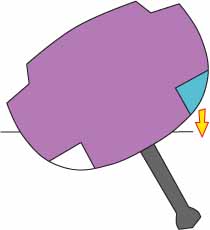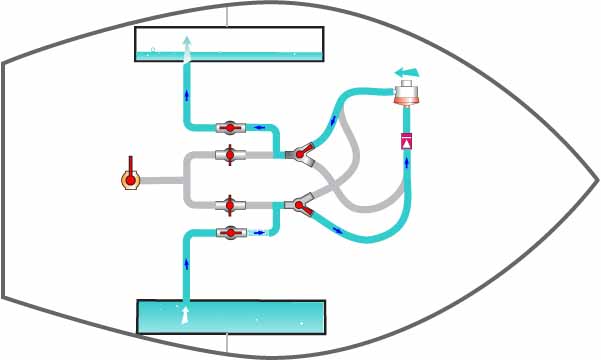- Home
- Cruising Boats
- Water Ballast System
Why a Water Ballast System is Worth Thinking About
A water ballast system in a cruising boat? Not a concept the traditionalists are likely to accept unreservedly. But providing the boat isn't dependent on this for stability it can be very beneficial in a seaway.
Such a water ballast system was part of the design philosophy when we built our cruising boat Alacazam, where it just supplements the permanent ballast in the keel bulb providing additional weight to windward when required.
The water is carried in two tanks on each side at the extremity of the waterline beam, each capable of being independently filled and drained by two 12v electric pumps. This is well below the point of maximum beam, but provides substantial benefits.
The Benefits of a Water Ballast System

- the boat's Centre of Gravity is no longer on the centreline, but is transferred outboard;
- as the boat heels, the righting moment increases due to the extended horizontal distance between the centre of buoyancy of the hull, and the centre of gravity of the water ballast;
- the Roll Moment of Inertia is significantly increased in terms of both pitch and roll;
- if caught with the water ballast on the wrong tack, the converse of the above applies such that the heel to leeward is not dramatically affected.
Freshwater or Seawater Water Ballast?
Initially the cruising man in me was reluctant to forego the increased freshwater capacity that the ballast tanks could provide, so they were used to supplement the standard water tanks located close to, and either side of, the centreline.
However, after lugging over 1,000lbs of this additional water all the way across the Atlantic without using any of it, I converted it to a seawater system.
 There's a fair amount of plumbing involved...
There's a fair amount of plumbing involved...Now I can get rid of it and replace it as required, and think of it as adjustable displacement. Tacking is done by opening a couple of simple valves and switching on the appropriate transfer pump. The boat's then tacked in the normal way, and then when the transfer is complete, the valves are closed and the pump's switched off.
Hard on the wind, with both windward tanks full, Alacazam heels about 6 degrees less for the same sail area and wind strength than she otherwise would, and sails quicker as a consequence. The concentration of outboard weight in the centre section of the boat noticeably improves the fore-and-aft stability, and coupled with less heel, reduces pitch and roll appreciably, the increased displacement making the boat generally more comfortable.
As the wind moves aft, the forward tank is drained and when well off the wind both tanks are drained. Of course in a short-tacking situation, the valve turning and pump switching involved in swapping the water from one side to the other requires a lot more rushing about that I'm accustomed to, so we only use the water ballast system on long offshore tacks.
The downside is that the tanks and the plumbing take up space that could otherwise be used for stowage, but there's no doubt that a moderate degree of water ballast in a light-ish displacement cruising yacht can improve both her performance and crew comfort.
Water Ballast: A Few FAQs...
What is a water ballast system?
What is a water ballast system?
A water ballast system is a device that allows a sailboat to fill or empty tanks with seawater to adjust its stability, trim, and performance. The water ballast can be transferred from one side of the boat to the other, or from the bow to the stern, depending on the sailing conditions.
How does a water ballast system work?
How does a water ballast system work?
A water ballast system works by using scoops, valves, pumps, and tanks to control the flow of water in and out of the boat. The scoops are openings in the hull that can be lowered or raised to capture or release water. The valves are switches that direct the water to the desired tanks. The pumps are devices that speed up the filling or emptying process. The tanks are containers that store the water ballast.
What are the benefits of a water ballast system?
What are the benefits of a water ballast system?
A water ballast system can provide several benefits for a sailboat, such as:
- Increasing stability by lowering the centre of gravity and reducing the angle of heel;
- Improving performance by optimizing the sail area and reducing the wetted surface;
- Enhancing comfort by smoothing the motion and reducing the rolling;
- Saving space and cost by eliminating the need for fixed ballast.
What are the drawbacks of a water ballast system?
What are the drawbacks of a water ballast system?
A water ballast system can also have some drawbacks for a sailboat, such as:
- Taking up precious room on board that could be used for storage or accommodation;
- Increasing complexity and maintenance costs due to the additional equipment and plumbing;
- Creating potential environmental issues by spreading invasive species or pollutants through the water exchange;
- Losing effectiveness at low speeds or when sailing upwind due to the reduced water pressure on the scoops.
How much water ballast do I need for my sailboat?
How much water ballast do I need for my sailboat?
The amount of water ballast needed for a sailboat depends on several factors, such as the size, shape, and design of the hull, the weight and distribution of the fixed ballast, the rig and sail plan, and the sailing conditions. There is no simple formula to calculate the optimal water ballast, but some general guidelines are:
- The water ballast should be between 10% and 30% of the total displacement of the boat;
- The water ballast should be placed as low and as far outboard as possible to maximize its righting moment;
- The water ballast should be adjusted according to the wind strength, wave height, and point of sail to achieve the best balance and trim.
The above answers were drafted by sailboat-cruising.com using GPT-4 (OpenAI’s large-scale language-generation model) as a research assistant to develop source material; to the best of our knowledge, we believe them to be accurate.
Recent Articles
-
Wauquiez Gladiateur 33 for Sale
Apr 10, 24 05:40 AM
'Kesh', my Wauquiez Gladiateur 33 is only for sale because we've decided to go for a larger sailboat. She currently berthed in Florida, USA. -
'Cabo Frio', a Catalina Morgan 43 for sale
Apr 01, 24 08:35 AM
This Catalina Morgan 43 is for sale at a very reasonable price. She offers up to 7 berths in 2 cabins + saloon. There is full 6'5" standing headroom and good ventilation throughout. -
Live Aboard Boats For Sale
Mar 30, 24 07:02 PM
Ready to live the dream? Then browsing through this listing of live aboard boats for sale might just get you on your way...












